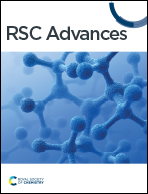Integrated resonance Rayleigh scattering approach utilizing Box–Behnken experimental design for the facile quantification of prucalopride in pharmaceutical tablets and human urine with sustainability assessment
Abstract
Prucalopride (PCP) is one of the recent drugs used for the regulation of gastrointestinal tract motility and the treatment of constipation. A new, highly sensitive and fast resonance Rayleigh scattering (RRS) approach was suggested for PCP determination. The approach was based on its reaction of PCP with eosin Y in buffered medium (pH 3.5) to form an ion pair association complex which had a significant enhancement in RRS compared to that of eosin Y or PCP alone. The enhancement of RRS intensity had straight correlation to PCP concentration ranging from 150 to 2000 ng mL−1 with 38 ng mL−1 as LOD and 125 ng mL−1 as LOQ. The measurements were done at a wavelength of 365 nm that provided the maximum sensitivity. All the experimental parameters were studied carefully and optimized via Box–Behnken experimental design. The International Council for Harmonization (ICH) guidelines were employed to validate the suggested method and the obtained results proved the appropriate method performance. The method was efficiently utilized to determine PCP in pure form, pharmaceutical tablets and spiked urine samples with no interferences from the surrounding matrices. Furthermore, the greenness of the suggested procedure was confirmed using different green metric approaches.



 Please wait while we load your content...
Please wait while we load your content...